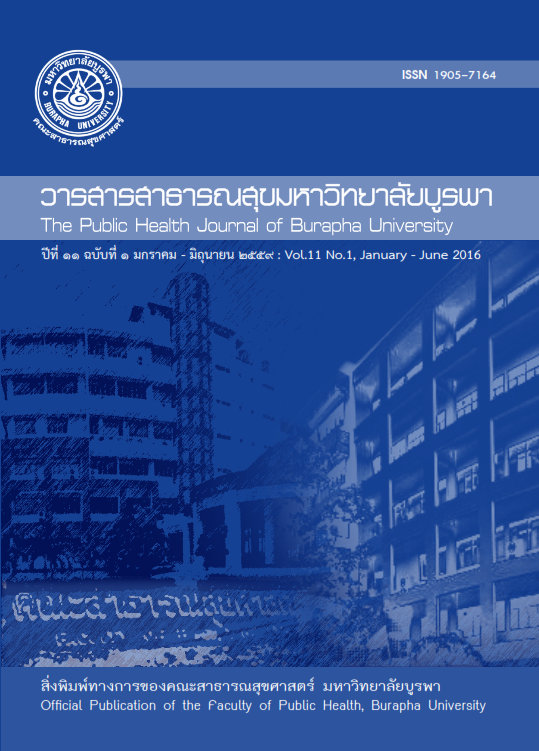สิ่งคุกคามในสภาพแวดล้อมการทำงานและความเสี่ยงทางการยศาสตร์ของทันตบุคลากร
Main Article Content
บทคัดย่อ
Work Environment Hazards and Ergonomic Risk of Dental Personnel
This survey study aimed to assess work environment hazards and ergonomic risk of dental personnel in the government hospitals of Khon Kaen Province. The study was conducted among 85 dental personnel from 85 hospitals by using forms of work environmental hazards identification, the checklist of dental instrument according to the standard and BRIEFTM survey for ergonomics risk assessment. The results indicated that health hazards in the working environment over 85% of dental professionals were physical hazards (i.e. light intensity, noise, and temperature), biological hazards (i.e. virus, bacteria) and chemical hazard i.e. amalgam (mercury). Dental instruments did not meet the dental health and safety standard over 50%, which were focus light intensity, patient chair, chair for the field, the light bulb for the general lamp. BRIEFTM survey by observation of working postures of dentists and dental hygienists showed the highest ergonomics risk from working posture while scaling (78.8%), followed by tooth fillings (77.7%). The highest risk for development of musculoskeletal disorders (MSDs) was presented at the area of the neck (78.8%), followed by the back (75.3%). Therefore, some hospitals should improve and perform the annual inspection of working instruments to meet the dental health and safety standard. Hospitals should promote dental personnel awareness to protect themselves from physical, biological, chemical hazards and ergonomic risk factors that might cause neck and back pain. Health surveillance of back and neck pain should be set up with ergonomics risk assessment.
การศึกษาเชิงสำรวจ นี้มีวัตถุประสงค์เพื่อประเมินสิ่งคุกคามในสภาพแวดล้อมการทำงาน และความเสี่ยงทางการยศาสตร์ของทันตบุคลากร ของหน่วยทันตกรรมในโรงพยาบาลของรัฐ จังหวัดขอนแก่น จำนวน 85 คน จาก 85 โรงพยาบาล รวบรวมข้อมูลโดยใช้แบบประเมินสิ่งคุกคามในสิ่งแวดล้อมการทำงาน ประเมินความเหมาะสมของเครื่องมือในงานทันตกรรม และการประเมินความเสี่ยงทางการยศาสตร์ โดย BRIEFTM survey ผลการศึกษาพบว่าสิ่งคุกคามด้านสิ่งแวดล้อมสูงกว่าร้อยละ 85 คือ ทางกายภาพ (แสงสว่าง เสียง อุณหภูมิ) ทางชีวภาพ (เชื้อไวรัส และเชื้อแบคทีเรีย) และทางเคมี คือสารอุดฟันอะมัลกัม (ปรอท) ด้านความเหมาะสมของเครื่องมือตามเกณฑ์มาตรฐาน พบว่าที่ไม่ผ่านเกณฑ์มากกว่าร้อยละ 50 คือ ความเข้มแสงที่ระบบโฟกัส เก้าอี้คนไข้ เก้าอี้สนาม ชนิดหลอดไฟจากแสงโคมไฟของชุดทันตกรรมเคลื่อนที่ เครื่องฉายแสง ผลการประเมินความเสี่ยงทางการยศาสตร์ในทันตแพทย์และทันตาภิบาล พบว่างานที่มีความเสี่ยงสูงสุด คือ งานขูดหินปูน (ร้อยละ 78.8) รองลงมาคืองานอุดฟัน (ร้อยละ 77.7) โดยอวัยวะที่มีความเสี่ยงสูงสุดต่อการเกิดความผิดปกติของระบบโครงร่างและกล้ามเนื้อคือ คอ (ร้อยละ 78.8) และรองลงมาคือหลัง (ร้อยละ 75.3) ผลการประเมินนี้เป็นแนวทางให้โรงพยาบาลจัดทำระบบการปรับปรุง และตรวจสอบเครื่องมือและอุปกรณ์ในงานทันตกรรมให้ได้มาตรฐานตามเกณฑ์และควรส่งเสริมให้บุคลากรมีความตระหนักด้านการป้องกันตนเองจากสิ่งคุกคามทั้งด้านกายภาพ เคมี ชีวภาพ และความเสี่ยงด้านการยศาสตร์ ที่อาจส่งผลต่อการปวดคอและหลัง หรือโรคเรื้อรังอื่นๆ จากการทำงาน โรงพยาบาลควรสนับสนุนระบบการเฝ้าระวัง ปัญหาการปวดคอ หลัง และไหล่ โดยให้มีการประเมินความเสี่ยงทาง
การยศาสตร์ร่วมด้วย
Article Details
เอกสารอ้างอิง
2. Barghout N, Habashneh R, AL-Omiri KM. Risk factors and prevalence of musculoskeletal disorders among Jordanian dentists. Jordan Med 2011; 45 (2): 195- 204.
3. Morse T, Bruneau H, Dussetschleger J. Musculoskeletal disorders of the neck and shoulder in dental professions. Work 2010; 35(4): 419-429.
4. Alexopoulos EC, Stathi IC, Charizani F. Prevalence of musculoskeletal disorders in dentists. BMC Musculoskelet Disord 2004; 5: 16.
5. Hayes M, Cockrell D, Smith DR. A systematic review of musculoskeletal disorders among dental professionals. Int J Dent Hyg 2009; 7(3):159-165.
6. Lindfors P, von Thiele U, Lundberg U. Work characteristics and upper extremity disorders in female dental health workers. J Occup Health 2006; 48: 192-197.
7. สำนักมาตรฐานงบประมาณ. ราคามาตรฐานครุภัณฑ์. (ออนไลน์). เข้าถึงได้จาก: http://president.yru.ac.th/plan/images/stories/files/plan_024_1.pdf. (วันที่ค้นข้อมูล 29 กันยายน 2554)
8. Li KW, Hsu YW, Tsai CH. Applying the BRIEF Survey in Taiwan’s High-Tech Industries. Inter J Computer, Internet & Management 2003; 11: 78-86.
9. Shapiro IM, Cornblath DR, Sumner AJ, et al. Neurophysiological and neuropsychological function in mercury-exposed dentists. Lancet 1982; 1: 1147-50. http://dx.doi.org/10.1016/S0140-6736(82)92226-7
10. สุวรรณี ตวงรัตนพันธ์, ทรงวุฒิ ตวงรัตนพันธ์, จินตนา อิธิเดธารณ, นิรมล เมธัสพรพงศ์. การสำรวจภาวะการเจ็บกล้ามเนื้อและโครงกระดูกใน ทันตแพทย์ไทย. [ม.ป.ท.: ม.ป.พ.]; 2539.
11. TUTB Newletters. Risk Assessment [online] 1997 [cited 2010 Sep 29]. Available from: http://hesa.etui-resh.org/en/newsletter/files/1997-06-p02-05.pdf
12. Nilsson T, Lundstrom R. Quantitative thermal perception thresholds relative to exposure to vibration. Occup Environ Med 2001; 58: 472-478.
13. คณะอนุกรรมการศึกษาและพัฒนามาตรฐานด้านความปลอดภัยการให้บริการทางทันตกรรม ทันตแพทยสภา. แนวทางปฏิบัติเพื่อความปลอดภัยทางทันตกรรม 2553. (ออนไลน์) เข้าถึงได้จาก: http://www.dentalcouncil.or.th/public_content/files/001/0000401_2.pdf (วันที่ค้นข้อมูล 19 เมษายน2558)
14. กระทรวงแรงงาน. มาตรฐานการบริหารจัดการด้านความปลอดภัย อาชีวอนามัยและสภาพแวดล้อมการทำงานด้านความร้อน แสงสว่าง เสียง พ.ศ.2549. (ออนไลน์) เข้าถึงได้จาก: http://www.labour.go.th/law/index.html. (วันที่ค้นข้อมูล 29 กันยายน2554 )
15. TUTB Newletters. Risk Assessment [online]. 1997 [cited 2010 September 29]. Available from:http://hesa.etui-esh.org/fr/newsletter/files/1997-06-p02-05.pdf.
16. รัชติยา นิธิธรรมธาดา, สุนิสา ชายเกลี้ยง. ความผิดปกติทางระบบโครงร่างและกล้ามเนื้อของทันตบุคลากรในสถานบริการของรัฐ จังหวัดขอนแก่น. วารสารวิจัย มข. 2556; 18 (5): 869-879.

